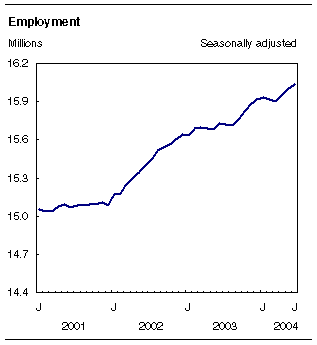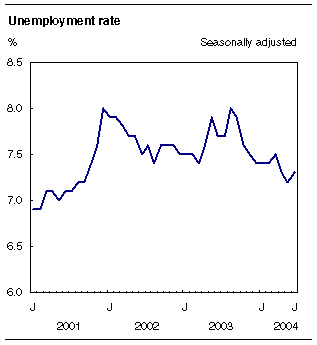
















 |
|
 |                |
Information identified as archived is provided for reference, research or recordkeeping purposes. It is not subject to the Government of Canada Web Standards and has not been altered or updated since it was archived. Please "contact us" to request a format other than those available.

|

Friday, July 9, 2004 Labour Force SurveyJune 2004Employment edged up by an estimated 25,000 in June, the third consecutive monthly increase. Despite a pause during the first quarter of the year, the increase in June brings job gains since August 2003, when the recent upward trend began, to 316,000 (+2.0%). The unemployment rate rose slightly in June, up 0.1 percentage points to 7.3%, the result of an increase in the number of people in search of work. 
More full-time jobsAll of the employment gains in June were full time. Since August 2003, full-time employment has grown by 342,000 (+2.7%), while part-time employment has declined by 27,000 (-0.9%). Weakness in part-time employment was concentrated mostly in the first quarter of this year. Despite little change in the number of hours worked (-0.2%) in June, continued strength in full-time employment has pushed the number of hours worked up 1.0% since the start of the year, slightly stronger than year-to-date employment growth (+0.7%). 
Improved labour market for youthsEmployment among youths increased by 32,000 in June, the third consecutive monthly increase, with the gain concentrated in full-time work (+23,000). The largest increases were in health care and social assistance, finance, insurance, real estate and leasing and retail sales. This month's increase brings overall employment gains among youths since March to 68,000 (+2.8%). These recent increases, all in full-time work, follow a period of continued weakness that began at the start of 2003. In June, the unemployment rate among youths fell 0.7 percentage points to 13.3%. The summer job market improved for students aged 20 to 24 (those who had been attending school full time and who plan to return in the fall). In June, the employment rate for 20- to 24-year-old students stood at 72.6%, a jump of 3.8 percentage points from June 2003. More were working full time this June compared with 12 months ago. Over the same period, the participation rate for this group of students increased 4.5 percentage points to 80.1%, pushing the unemployment rate up slightly by 0.4 percentage points to reach 9.4%. Younger students aged 15 to 19 did not fare as well as older students in the summer job market. The proportion of teenage students with a job fell from 43.2% in June 2003 to 42.1% in June 2004. Over the same period, the labour force participation rate for these students decreased 1.3 percentage points to 51.1% while their unemployment rate was unchanged at 17.6%. Overall employment among adult women was little changed in June as a decline in full-time employment (-33,000) was partly offset by a gain in part-time jobs (+ 22,000). Despite little change this month, employment among adult women is up 148,000 (+2.4%) since last August when the upward trend began for this group. Over this period, all of the gains have been in full-time work. In June, the unemployment rate for adult women edged up 0.2 percentage points to reach 5.9%. Employment among adult men was also little changed in June as a gain of 38,000 full-time jobs was offset by a decline of 34,000 in part-time employment. So far this year, employment growth has slowed for this group, with gains totalling only 34,000 (+ 0.5%). This contrasts with the last four months of 2003 when employment was up 74,000 (+1.0%). In June, the unemployment rate for adult men edged up 0.2 percentage points to 6.2%. More jobs in salesIn June, employment rose by 21,000 in retail and wholesale trade with the largest gains in wholesale building materials and supplies, and in retail food and beverage stores. This month's increase in retail and wholesale trade offsets losses earlier in the year and leaves employment in the sector up by only 0.6% (+14,000) since the start of the year. Employment in construction edged up 9,000 in June, building on the gains observed over the previous two months. Following a pause earlier in the year, employment in the sector is up 42,000 (+4.5%) since March, resuming the upward trend that began about three years ago. There were 14,000 more people working in information, culture and recreation in June, offsetting the decline in the previous month. This leaves employment in this sector at about the same level as at the start of the year. In June, employment fell by 15,000 in other services, mostly in private household services, as well as in personal, laundry and dry cleaning services. Employment in manufacturing edged down 12,000 in June. This offsets the gain in May and continues a period of little change that began during the fall of 2003. Employment in manufacturing has not recovered from the losses incurred between November 2002 and September 2003. More public sector employeesJob gains in June were all among public sector workers (+32,000), with the largest increases in health care and social assistance, as well as in transportation and warehousing. So far in 2004, employment among public sector employees is up 2.4% (+75,000), while the number of private sector employees has shown little change. Year-to-date employment gains among the self-employed is up 1.2% (+29,000). Job gains in British ColumbiaEmployment in British Columbia increased by 27,000 in June, the second consecutive monthly increase, bringing gains since April to 42,000 (+2.1%). Despite recent increases, there were offsetting losses earlier in the year, leaving year-to-date employment little changed. The largest increases in June were in information, culture and recreation; construction; and health care and social assistance. The unemployment rate fell 0.3 percentage points to 7.5%. Employment in Ontario edged up 18,000 in June, the third consecutive monthly increase. These recent gains follow weakness in the first quarter of the year and resume the upward employment trend that began last August. The increase in June was mainly concentrated in accommodation and food services. While youth employment has been sluggish during the first five months of this year, it accounted for most of the increase in June. The overall unemployment rate in the province was unchanged in June at 7.0%. In Quebec, employment edged down 15,000 in June, all in full-time work. Declines were concentrated in manufacturing, natural resources and other services. This month's decline leaves employment in the province little changed since the start of the year. In June, the unemployment rate edged up 0.2 percentage points to 8.2%. There was little change in employment in the other provinces. Available on CANSIM: tables 282-0001 to 282-0042 and 282-0047 to 282-0095. Definitions, data sources and methods: survey number 3701. Available on our website at 7:00 am. From the home page, choose Today's news releases from The Daily, then Latest Labour Force Survey. A more detailed summary, Labour Force Information (71-001-XIE, $9/$84), is available today for the week ending June 19. Data tables are also available in the Canadian Statistics module of our website. The next release of the Labour Force Survey will be on Friday, August 6. For general information or to order data, contact Client Services (1-866-873-8788; 613-951-4090; labour@statcan.gc.ca). To enquire about the concepts, methods or data quality of this release, contact Vincent Ferrao (613-951-4750) or Stéphanie Langlois (613-951-3180), Labour Statistics Division.
| |||||||||||||||||||||||||||||||||||||||||||||||||||||||||||||||||||||||||||||||||||||||||||||||||||||||||||||||||||||||||||||||||||||||||||||||||||||||||||||||||||||||||||||||||||||||||||||||||||||||||||||||||||||||||||||||||||||||||||||||||||||||||||||||||||||||||||||||||||||||||||||||||||||||||||||||||||||||||||||||||||||||||||||||||||||||||||||||||||||||||||||||||||||||||||||||||||||||||||||||||||||||||||||||||||||||||||||||||||||||||||||||||||||||||||||||||||||||||||||||||||||||||||||||||||||||||||||||||||||||||||||||||||||||||||||||||||||||||||||||||||||||||||||||||||||||||||||||||||||||||||||||||||||||||||||||||||||||||||||||||||||||||||||||||||||||||||||||||||||||||||||||||||||||||||||||||||||||||||||||||||||||||||||||||||||||||||||||||||||||||||||||||||||||||||||||||||||||||||||||||||||||||||||||||||||||||||||||||||||||||||||||||||||||||||||||||||||||||||||||||||||||||||||||||||||||||||||||||||||||||||||||||||||||||||||||
|
|
|